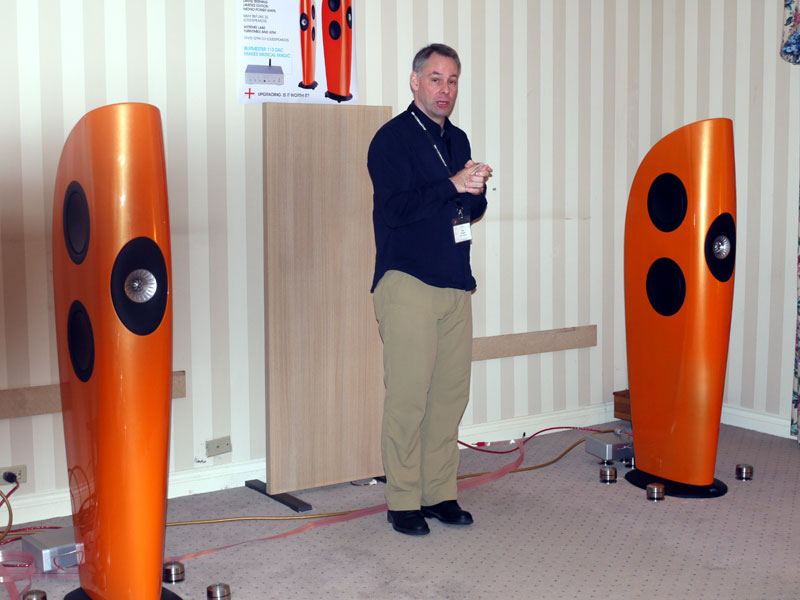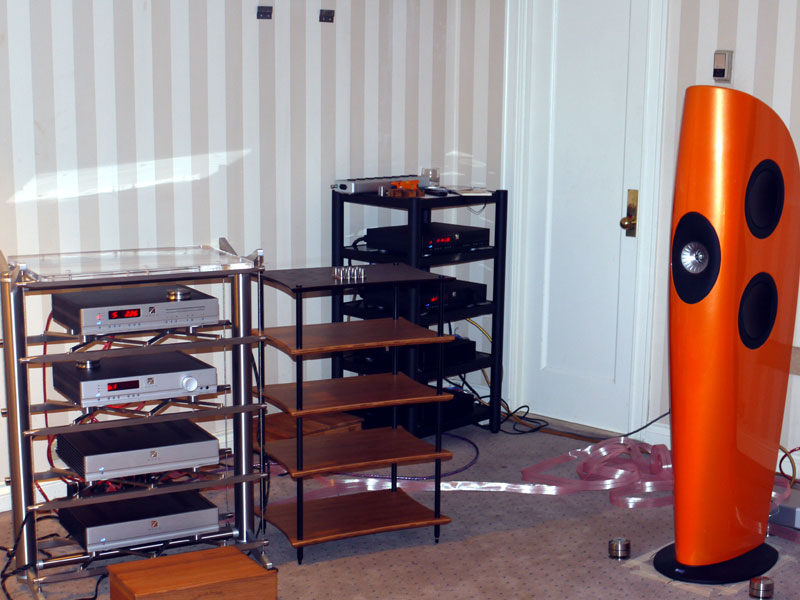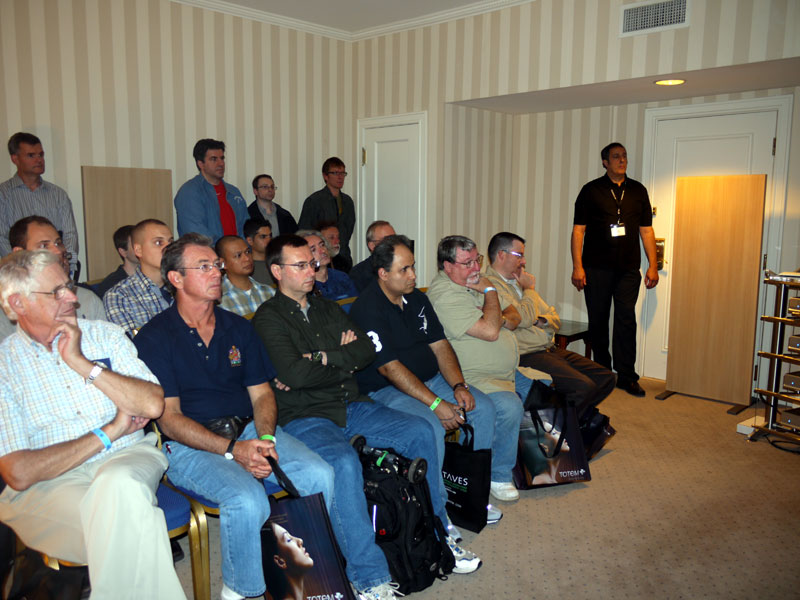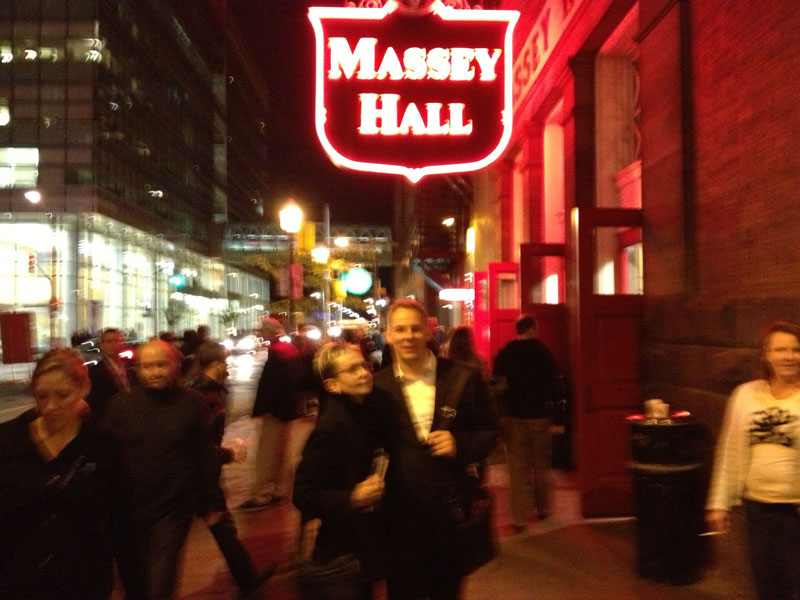The Audio Beat's System Setup and Optimization Seminar
The starter system and setup Simaudio Moon 360D CD player The electronics and speakers were constant throughout, although we did use two sets of electronics to ease the process.
We used a mixed selection of power cords from van den Hul, Kimber, TCI and Music Works, along with a Music Works distribution block. Interconnects came from Reference Cables and Hovland, while the speaker cables were top-of-the-line van den Hul from several years ago. The specific identity of the cables wasn’t important, just the fact that I had as many different brands as possible within a single system. That’s what did the damage, not whether or not these were good or bad cables per se. Rack: a welded steel Target HF570 with glass shelves.
The music Throughout the show I used the following tracks to introduce the system. Julia Fischer: Bach Partita No. 2 for solo violin
[Pentatone PTC 5186 074] These sounded nice enough, but then I used something a little more rhythmically testing to show what the system wasn’t doing. Art Pepper Quintet: "Las Cuevas De Mario," Smack Up [Analogue Productions CAPJ 012]. The process Step 1 - We moved the speakers, each by about half an inch, to show the importance of precise positioning. Step 2 - We lifted the speakers, each on a quartet of Stillpoints Ultra 5 feet. As well as improving coupling to the floor, these allowed us to set the vertical and rake angles for the Blades. Step 3 - We changed to the second set of electronics, positioned on a carefully leveled Quadraspire Q4 Evo rack and wired up with a complete set of Nordost Heimdall 2 cables, from wall socket to speaker binding posts, along with a Quantum Qbase QB8 distribution block. The top shelf of the rack, used for the CD player, was of MDF, while the other shelves were of laminated and grooved bamboo. Step 4 - We placed three small hardwood blocks under each of the electronics, bypassing the feet and improving their coupling to the supporting surface, allowing internally generated mechanical energy to escape from the chassis. Step 5 - We moved the CD player (along with its three wood blocks) from the top MDF shelf down one step to a bamboo shelf, showing just how important the supporting shelf becomes, once you couple the equipment properly. Track change - Having established a good, basic foundation (mechanical and electrical) for the system, we once again changed tracks, this time to highlight differences in the next step. Shawn Colvin: "The Facts About Jimmy," A Few Small Repairs [Columbia 454327 2]. Step 6 - We replaced the wood blocks with trios of Stillpoints Ultra Minis. These not only improved the coupling of electronics to the shelves, but increased the consistency of support, with Stillpoints technology now being used under both the electronics and the loudspeakers.
Step 7 - We took the last step in the support chain, raising the Quantum distribution unit onto three Stillpoints Ultra 5s, placing a mechanical drain between the mechanical energy carried on the electrical grid and the electronics themselves. Step 8 - Having improved the mechanical grounding of the system, we next did the same for the electrical supply. To do this we ran a ground wire from the star ground terminal on the Quantum Qbase to an Entreq Tellus ground block. Track change - With the system starting to sound considerably better, especially with the Shawn Colvin track, it was time once again to show what it wasn’t doing. We changed tracks to Joe Cocker: "Many Rivers To Cross," Sheffield Steel [Mobile Fidelity UDCD 631]. Step 9 – The big one! We now moved the whole set of electronics from the Quadraspire rack to the Stillpoints ESS, fitted with Ultras and the new Grids. This not only increased the sophistication and degree of mechanical draining, it eliminated the shelf material altogether. Step 10 - We replaced the internal, hardwired links on the KEF Blades with a set of Nordost Norse-series biwire jumpers. Step 11 - We added a clean signal ground, by linking the outer ring of an unused RCA input on the preamp to a second Entreq grounding box -- in this case a Silver Tellus. Step 12 - We ran two more wires, from bottom front left and top rear right corners of the rack to the Silver Tellus, thus creating a Faraday Cage around the equipment to help eliminate radio-frequency interference. Step 13 - We added a pair of Quantum QRT Qx4 field generators to the system, positioning one each behind the speakers. Step 14 - Finally, it was time to demonstrate the impact of the Leading Edge acoustic panels we’d used to treat the room -- by simply removing them! Step 15 - With the Leading Edge panels reinstalled, it was time to revisit the original tracks we’d played, but each with a wrinkle. Art Pepper: also used to show the effect of damping the CD and preamp chassis with Stillpoints LP Isolator weights. Step 16 - Cat Stevens: including a small demonstration of the deleterious impact of remote operation on the system. Step 17 - Buddy Holly, but also Rachmaninoff: Symphonic Dances, Johanos, Dallas S.O. [Analogue Productions APCD 006]. Step 18 - A return to the system as originally heard. Running any demonstration of this complexity demands considerable time, effort and expenditure on the part of those people and companies that support it. With that in mind I’d like to thank TAVES for supplying the space and Nordost for sponsoring the presentation, as well as supplying equipment. I’d also like to thank Simaudio for supplying not one but two complete sets of electronics (as well as acting as a freight forwarder!); KEF USA for the generous loan of the Blades (in glorious burnt orange finish!); Bluebird Music for the Quadraspire rack (including the extra shelf and bits we demanded); Leading Edge for the invaluable contribution of their acoustic panels; and Liberty Trading, Inc., who saved our bacon with the last-minute loan of the Target rack (we owe you big time). Last, and by no means least, a special thank you to Paul Wakeen of Stillpoints, who not only supplied the vast array of support devices as well as the grounding blocks used in the demonstration, but also generously gave his time to help set up, operate and break down the whole event.
TAVES was a musical blur, and this picture captures the experience perfectly. Finally, I can thank all those who took the time to sit
for over an hour in a sweltering room. Thank you to everybody for your help, your support
and your attention. |




